Ariane 5 Data Sheet: Ariane 5 was developed by the European Space Agency to replace Arianespace’s Ariane 4 commercial satellite launcher. The big rocket was originally sized to launch two 2-3 metric ton (tonne) satellites to geosynchronous transfer orbit (GTO) at a time. It was subsequently upgraded to handle dual 5 tonne payloads.
Ariane 5 uses 2.5 stages and four motors. At liftoff, its twin segmented solid motors provide more than 500 tons thrust each to augment the single core stage Vulcain LOX/LH2 engine’s 110 tons of thrust. The original Ariane 5 G (“Generic”) version used a hypergolic EPS second stage with a 2.6 ton thrust Aestus engine.
Ariane 5 ECA uses an “E” (“Evolution”) core stage, powered by an upgraded Vulcain 2 of 138 tons thrust, and an ESC-A upper stage. ESC-A is an upgraded Ariane 4 LOX/LH2 third stage with a 6.4 ton thrust HM7B engine. Slightly upgraded solid motors were also developed to power the “E” vehicles. Ariane 5 ECA can boost more than 10 tons to GTO. It stands nearly 58 meters tall with a long payload fairing.
Long term plans call for possible development of a new 15 ton thrust Vinci engine to replace the HM7B engine. The reengined stage, named ESC-B, would allow the upgraded Ariane 5 ECB to launch 12 tons to GTO.
A fourth Ariane 5 variant, named Ariane 5 ES(V) (also called Ariane 5 “Versatile”), flew for the first time in March 2008. This version uses the “E” core stage and the same solid rocket boosters as the Ariane 5 ECA. Ariane 5 ES(V) uses an Aestus-powered storable propellant (EPS-V) stage that can carry as much as 10 tons of propellant, 0.3 tons more than the initial model, although smaller propellant loads are used for low earth orbit missions. Unlike earlier “G” model EPS stages, the “ES(V)” EPS-V stage can be restarted. Ariane 5 ES(V) was developed to launch Europe’s 20 ton ATV automated cargo carrier to the International Space Station (ISS).
Two interim G-series models appeared during the G to E transition period. Ariane 5G+ was a standard Generic model topped by the 10-ton propellant EPS upper stage that flew during 2004. Ariane 5GS added the improved E-class solid motors to the G+ configuration.
Ariane 5’s solid boosters are produced adjacent to the new ELA-3 launch site at Kourou Space Center, stacked in a dedicated building on a launcher platform, then rolled to the launcher integration building. There, the first and second stages are mated. Although the site is designed to support 6-8 Ariane 5s per year, only 3 were launched each year during the 2002 to 2004 period.
Ariane 5 qualification testing began inauspiciously on 4 June 1996, when Ariane 501 exploded 39 seconds after launch from Kourou. A guidance system failure was blamed. Successor Ariane 502 made it to orbit on 30 October 1997, but first stage roll-control problems caused a slight loss of velocity and the test payloads fell just short of their planned geosychronous transfer orbit (GTO). Ariane 503 finally qualified the vehicle with a successful flight on 21 October 1998. All three of the test flights carried dummy or experimental payloads. Ariane 504 inaugurated commercial service on 1999 December 10 when it orbited ESA’s 3,764 kg X-Ray Multi-Mirror spacecraft. By early 2007, the Ariane 5G series had achieved 21 successes in 24 flights, including 14 consecutive successes.
A failed Vulcain-2 engine doomed the inaugural Ariane 5 ECA flight (Ariane 517) on December 11, 2002, destroying the Hotbird 7 communications satellite. After an extensive Vulcain-2 redesign and testing effort, Ariane 5 ECA finally flew successfully on February 12, 2005 when Ariane 521 boosted XTAR-EUR and MaqSatB2 into GTO.
The first Ariane 5 ES flight, the March 9, 2008 V-181 mission, successfully orbited 19.012 tonne ATV-1 “Jules Verne” into a 51.6 deg low earth orbit.
Space Launch Report: Ariane 5 Data Sheet
| LEO Payload (metric tons) (800 km SSO) (500 km ISS) | GTO Payload 1500 m/s to GEO* (metric tons) | Configuration | LIftoff Height (meters) | Liftoff Mass (metric tons) | |
| Ariane 5G | 9.5 t (SSO) | 6.64 t | G Core + 2 SRB + EPS | 54 m | 720 t |
| Ariane 5 ES(V) | 15.7 t (SSO) 19.3 t (ISS) | 7.575 t | E Core + 2 SRB + EPS-V | 53.4 m | 756 t |
| Ariane 5 ECA | 10.05 t | E Core + 2 SRB + ESC-A | 57.7 m | 764 t | |
| Ariane 5 ECB | 12 t | E Core + 2 SRB + ESC-B | 57.7 m | 764+ t |
* GEO: Geosynchronous Earth Orbit
Vehicle Components
| SRBs EAP-G (EAP-E) | Cryo Core (EPC) Generic (“G”) | Cryo Core (EPC) Evolution (“E”) | EPS (EPS-V) | ESC-A | ESC-B | |
| Diameter (m) | 3 m | 5.4 m | 5.4 m | 5.4 m | 5.4 m | 5.4 m |
| Length (m) | 31.6 m | 30.5 m | 30.5 m | 4.711 m | ||
| Propellant Mass (tons) | 237 t (240 t) | 158 t | 175 t | 9.7 t 10 t (V) | 14.9 t | 25 t |
| Total Mass (tons) | 268 t (278 t) | 170 t | 189 t | 10.9 t 11.3 t (V) | 19.44 t | |
| Engine | Vulcain | Vulcain 2 | Aestus | HM7B | Vinci | |
| Fuel | LH2 | LH2 | MMH | LH2 | LH2 | |
| Oxidizer | LOX | LOX | N2O4 | LOX | LOX | |
| Thrust (vac tons) | 509.9 t | 112.167 t | 137.662 t | 2.957 t | 6.424 t | 15.3 t |
| ISP (vac sec) | 274.5 s | 431.2 s | 431.2 s | 321 s | 446 s | 466 s |
| Burn Time (sec) | 130 s | 600 s | 540 s | 1000 s (V) | 945 s | |
| No. Engines | 1 | 1 | 1 | 1 | 1 | 1 |
Vehicle Components, Cont’d
| VEB | Sylda 5 | Speltra | Short Fairing | Long Fairing | ||
| Diameter (meters) | 5.4 m | 5.4 m | 5.4 m | |||
| Length (meters) | 1.56 m | 12.7 m | 17 m | |||
| Mass (tons) | 1.9 t | 0.425-0.5 t | 0.716-0.822 t | 2.5 t |
References
Ariane 5 User’s Manual, Arianespace, November 2004
V-181 Press Kit, Arianespace, March 2008



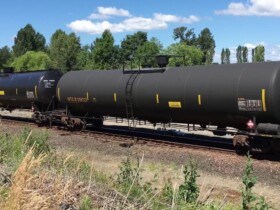
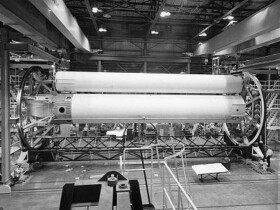


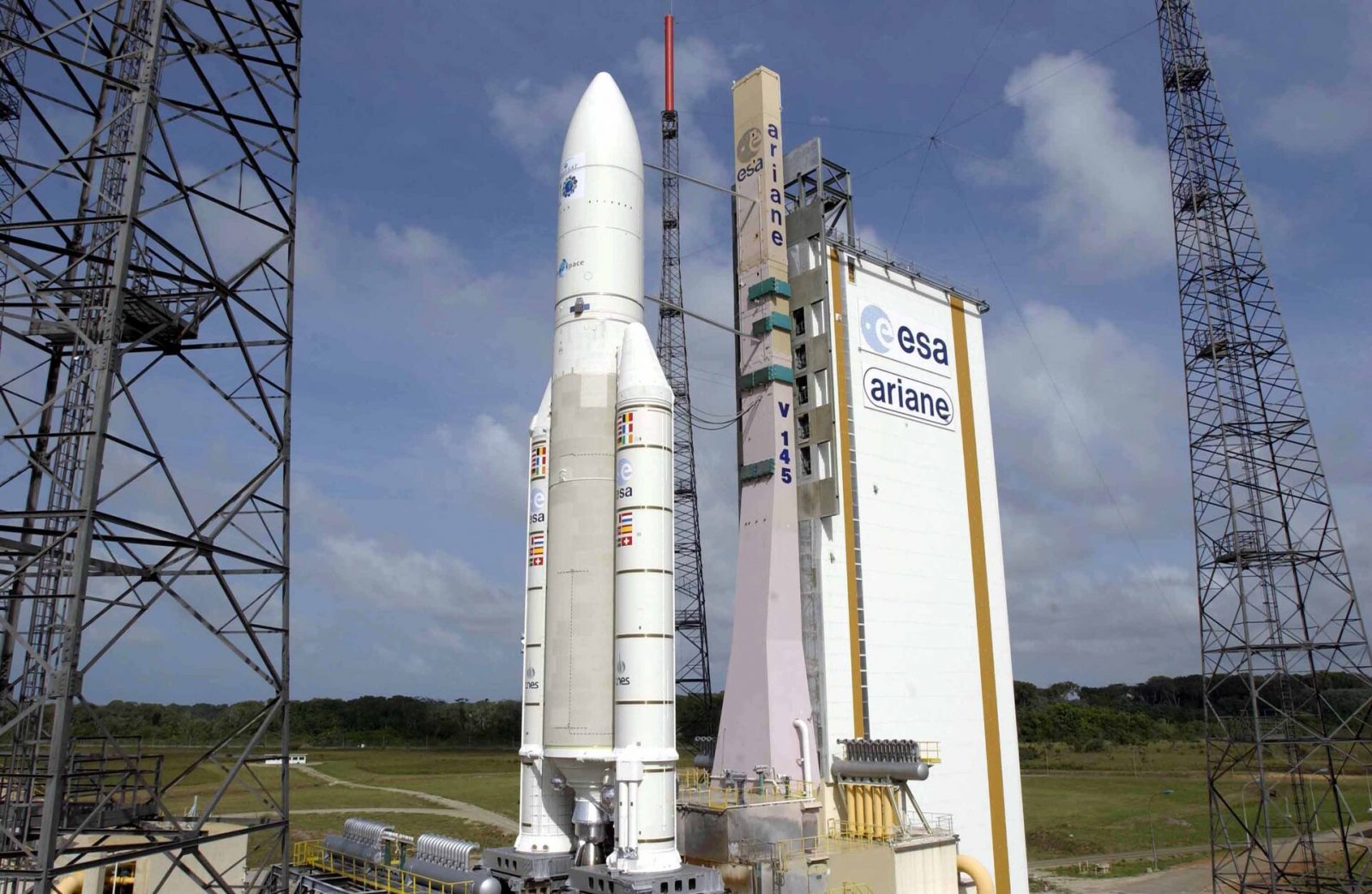
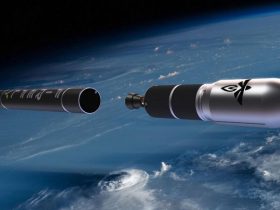







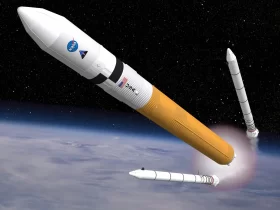
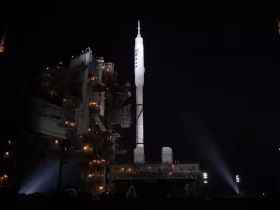
Got a Questions?
Find us on Socials or Contact us and we’ll get back to you as soon as possible.